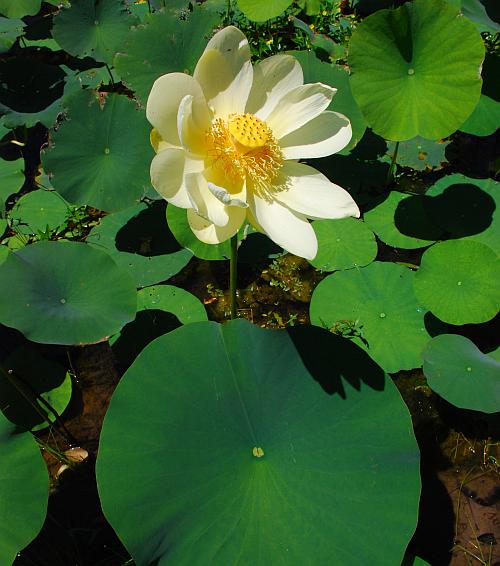Nelumbo lutea Willd.
American Lotus

Native
CC = 6
CW = -5
MOC = 38
© SRTurner
Nelumbo lutea Willd.American Lotus | |
 |
Native CC = 6 CW = -5 MOC = 38 |
© SRTurner |
|
Family - Nelumbonaceae Habit - Perennial aquatic forb, with milky latex and extensive, branching, spongy rhizomes, rooting at the nodes and bearing large, banana-shaped tubers (produced in autumn). Stems - Aerial stem absent. Leaves - Spirally alternate, mostly long-petiolate, the petiole smooth, to 3 m or more, relatively stiff and stout, reaching the water surface or emergent to about 80 cm. Stipules apparently absent, but perhaps represented by small, sheathing scales at the petiole bases. Leaf blades to 60 cm in diameter, centrally peltate, circular, the margin entire but slightly undulate, the upper surface flat (in floating blades) to moderately concave (in emergent blades) about the central attachment point (visible as a pale, scarlike mark), glabrous, often somewhat glaucous, the undersurface pale but with small brown spots, the main veins numerous, palmate from the petiolar attachment, mostly branched dichotomously 2 or more times, raised on the blade undersurface, connected by a network of finer crossveins.
Inflorescences - Solitary flowers, these long-stalked directly from the nodes of the rhizome, emergent and usually slightly overtopping the emergent leaves. Flowers - Hypogynous, perfect, actinomorphic. Perianth showy, creamy to pale yellow, of numerous, spirally arranged, overlapping tepals; the outermost 3-5 tepals 0.8-1.4 cm long, often green or greenish-tinged; grading into the median tepals, these 7-12 cm long, obovate; grading into the innermost ones, these somewhat shorter, lanceolate, grading into the stamens. Stamens numerous, arranged in a dense, overlapping spiral, the filament 6-12 mm long, slender, the anther 9-18 mm long, attached at the base, orangish yellow, with a terminal appendage 3-5 mm long. Pistils 8-32, simple, free from one another, embedded in deep pits along the upper surface of a large, flat-topped, conic, spongy, expanded receptacle, this continuing to expand as the fruits mature, becoming nodding, dark brown, enlarged to 10 cm, and somewhat leathery to hardened at fruiting. Style 1 per ovary, very short, the stigma protruding through an apical pore in the receptacle pit, more or less disc-shaped, slightly concave and with a central pore. Ovule 1 per carpel, the placentation apical.
Fruits - Aggregate fruits consisting of nuts embedded in the long-persistent, greatly expanded receptacle. Nuts 9-16 mm long, nearly spherical, indehiscent, hard-walled, brown to nearly black.
Flowering - June - September. Habitat - Lakes, ponds, sloughs, marshes. Origin - Native to the U.S. Lookalikes - None. Other info. - This strikingly bizarre species is probably found throughout Missouri, although it is under-documented by voucher due to its large size and aquatic habitat. Its range includes the eastern half of the continental U.S., though most commonly in the Midwest, and also Mexico and Central America. It is easily recognized by its large, circular, peltate leaves and large flowers, and later by the strange fruiting receptacles. These fruiting heads have been used in dried flower arrangements.
Photographs taken at Busch Wildlife Area, St. Charles County, MO, 06-28-2009, 07-27-2011, and 06-29-2012, Shaw Nature Reserve, Franklin County, MO, 10-11-2016, and Glassberg Conservation Area, Jefferson County, MO, 6-28-2023 (SRTurner). |